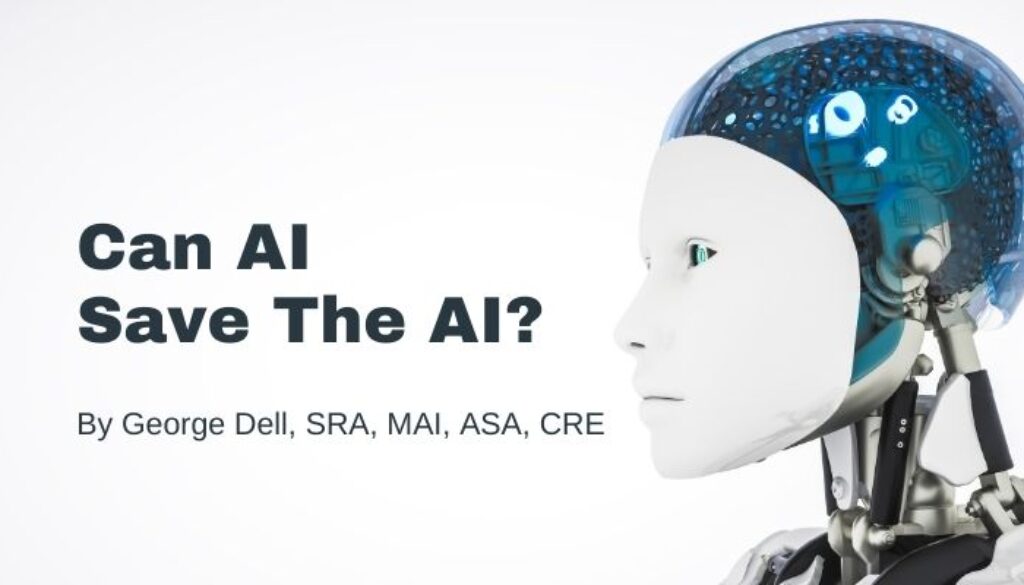AI is “Artificial Intelligence.” The AI is Appraisal Institute.
Artificial intelligence is a part of data science. Appraisal comprises science and art. Let’s take a look at what the primal AI intended, and what happened.
Which is which? Once upon a time, science and art aspired to be the same. Just different words.
What was intended
The 1932 American Institute of Real Estate Appraisers (a predecessor to the AI) presents its primary purpose: “the advancement of the science of appraising” [emphasis added]. It went on to say: “An appraisal must always be a judgment. A scientifically formed judgment is one thing, while a haphazard guess is quite another.” *
Similarly, the 1935 Society of Real Estate Appraisers (the joint predecessor to the AI), “A Guide to Appraising Residences,” states three goals: raise standards, advance professional standing, and “to provide members with useful appraisal information to enable them to make more reliable appraisals.”
Early on, artificial intelligence was science fiction. Today’s concept of artificial intelligence is different. We did not have the electronic data, nor computer power. But the emphasis on science and reliability was there. Just not yet measurable.
The use of science (systematic study by an expert) is measured with the word “reliable.”
What happened
It is important to note that the word “reliable” reflects the quality of the work. Contrarily, today’s word “credible” (as defined in USPAP) — reflects believability, or worthiness of belief – focuses on the expert, not the work product!
Along the way, appraisal purpose changed from an estimate of value to an opinion of value. And the goalpost moved from “reliable” to “believable.”
Of course, this mental focus on the appraiser (rather than the analysis itself) makes it easier to accuse and sue the appraiser, rather than accuse the analysis. “Be worthy, not reliable.” Words have power. Words can frame the entire culture of providers, users, regulators, and the Appraisal Institute itself.
This is even more important in the context of today’s complete paradigm shift into data, computation, and ability to integrate human expertise through visualization.
We lost the emphasis on science and reliability. We even lost the goal of systematic study, favoring the old way of doing things: “trust me” believability and personal worthiness. The “established” body of knowledge is established. Clients expect, and peers peer. What could possibly go wrong?
What can happen
Today, we have complete (or substantially complete) data. Even in non-disclosure states, or in sparse-data situations, we at least know what the complete data set looks like, even if we lack sale prices on all. We have computer power. Power to sharpen expert decisions of judgment. Power to deliver results, including measurable reliability. Power to understand the marketplace as well as specific competitive similarity. We have the power to intersect expert intelligence with artificial intelligence.
The AI is in the best position to take leadership. The AI must embrace AI. For its own relevance and even survival. For the public good. For personal fulfilment. Just to make appraisal fun again.
* Thanks to Bruce Hahn, MAI, SRA, CRE, CCIM, for tracking down the AI history.

August 12, 2022 @ 9:27 am
My first computer class in college was an ethics class, this was 1975. By then I had already read Isaac Asimov’s laws of robotics which were written 30 years earlier during WWII (now 80 years ago). Unfortunately, the many generations since then have misunderstood their ethical meaning (to our present and future detriment). What has never left my conscious since that class is that bias is pervasive, even down to the zeros and ones in computer code, and unless you know the bias of the author of that code you will never properly know how that program will run. The raw collection and storage of data in the computer age is amazing, it is the cataloging, manipulation and interpretation of that data that is fearsome. Up until the next micronova Carrington type event this is our reality. The fact that I can use DOS commands means that the foundation of the computer age is built on past mistakes, incomplete data, and code bias.
Judgment comes as a result of critical thinking, and so few are taught how to critically think, especially at an early age (it is the nemesis I face in the product I receive from appraisal professionals, that and curiosity).
I am encouraged that you will get to speak to the AI conference.
August 12, 2022 @ 12:47 pm
And,… Protections within AI, analogous to Asimov’s Rules of Robotics seem to be rarely considered. Those laws seem like a good start, but the programmer’s bias (or greed, or power lust) will inevitably be problematic. A solid ethical committee with sufficient honesty and technical and legal expertise might help. (Uniform Standards of Professional Programming?!?!)
(First Law — A robot may not injure a human being or, through inaction, allow a human being to come to harm.
Second Law — A robot must obey the orders given it by human beings except where such orders would conflict with the First Law.
Third Law — A robot must protect its own existence as long as such protection does not conflict with the First or Second Law.)
August 16, 2022 @ 12:31 pm
George, well done, thanks for the reminder of why appraisal organizations were started.